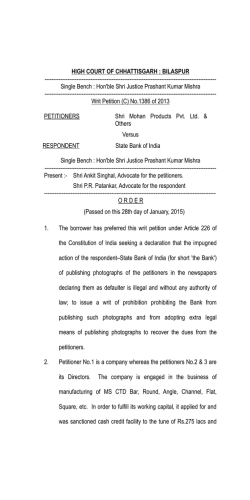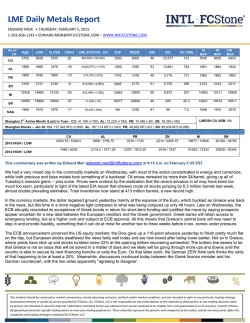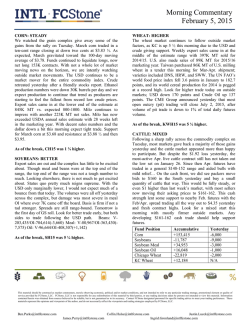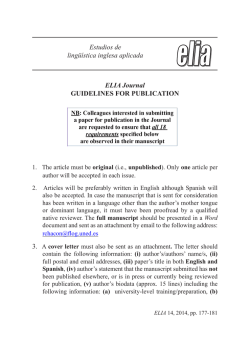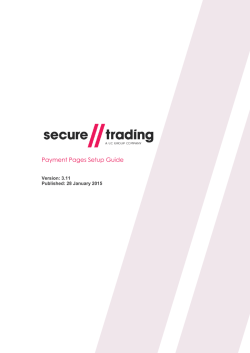
February 3, 2015 - s3.amazonaws.com
February 3, 2015 Greetings, We have only just started to see the effects of a bust spreading through the world’s energy complex. With earnings season underway, energy companies are announcing plans to slash billions of dollars in spending along with thousands of jobs. The counterargument to oil’s current drag on economic growth is that cheaper gasoline acts as a tax cut for consumers. As I’ve said previously, that’s only true if consumers take those savings and spend them, but they’re not. Visa’s (V) fourth quarter earnings call did a great job of quantifying the impact cheaper gasoline. Quoting from the conference call, ”US fuel prices are down ~30% since June. The drop amounts to ~$60/month for the avg. consumer according to our survey. Approximately 50% of the savings are being saved, 25% is being used to pay down debt and ~25% is being spent in other discretionary categories.” Remember, deflation increases real interest rates, making debt more expensive and cash more valuable. Therefore it makes perfect sense that 75% of the money saved through lower gasoline prices is not being redeployed back into the economy. It’s also not surprising that new orders for durable goods dropped substantially in December, breaking a major trend line in the process. December could prove to be a fluke, but the two times durable good orders broke lower in this manner it marked a top in the stock market. This is hardly the only reason to be bearish – more on that subject in the body of this week’s letter. I’ve maintained a relatively agnostic view of the stock market since launching this newsletter last July, but my outlook has grown increasingly negative. January is often seen as a bellwether month that indicates how the rest of the year will play out. The S&P 500 finished January down 4% in choppy trading, which could be the theme of 2015. This is not a fatalistic newsletter. I don’t think there will be a systemic crisis in the next six months. The Fed still has ammo to keep asset prices elevated if trouble arises. However, the downdraft in stocks and credit last October highlighted how quickly prices can fall without sufficient liquidity. I’ve written previously that the lack of underlying liquidity is the biggest risk in the market, and it would not surprise me if another “Flash Crash” occurred in the near future. There was more trading than usual in the Cup & Handle Fund last week, and returns were roughly flat. My outlook is bearish, but I should point out that I’m typically early to these trends and by no means is the portfolio positioned for the apocalypse. Instead, I’m maintaining some structural positions, keeping cash on hand and waiting patiently for the signals. I recorded a podcast with the American Monetary Association last week, and I’ll pass along the link once it becomes available. I’m also now focusing on the February investment letter, which won’t necessarily advocate a short sale – if you’d like to start receiving these letters click here. Today’s letter will cover several topics, including: The Apple Effect Alarm in Singapore Dire Predictions Chart of the Week As always, if you have any questions or comments or just want to vent, please send me an email at [email protected]. Until next time, tread lightly out there, Michael Lingenheld Managing Editor – Cup & Handle Macro AAPL Keeps The Doctor Away Prior to last Tuesday, more than one-third of the S&P 500 had released 4Q results, registering 2% earnings growth. After Apple (AAPL) released its 4Q results on Tuesday afternoon, aggregate earnings growth for the entire index jumped to 6.5%. Fueled by record iPhone demand, Apple’s quarterly profit was $18 billion, which is more than 435 of companies in the S&P 500 have made in total profits since 2009. It was the greatest quarter in corporate history. The numbers would have been even more impressive had currency fluctuations not shaved 4% off revenue. With a $680 billion market cap, Apple is more than half the size of Germany’s stock exchange – the DAX. The cash on Apple’s balance sheet, $178 billion, is 6 times the size of Netflix’s market value. All this from a company that derives most of its revenue from telephones. However, Apple can’t carry the economy, or even the tech sector, by itself. The past month has seen the biggest drop in 12month forward earnings estimates since 2009. Going back to 1985, the change in forecasts over the past year has only been worse during recessions. Amazon (AMZN), which has grown to prominence through high volumes and razor-thin margins, is struggling. Even though 4Q numbers were better than anticipated, Amazon has earned less than $2 billion in net profits throughout its entire history as a public company dating back to 1997. The company’s $400 billion in sales during that time is impressive, but it took Apple 11 days to make $2 billion last quarter. The two major themes of earnings season so far have been A.) Layoff announcements and B.) The stronger US Dollar weighing on results. As the world’s largest company, Apple plays an outsized role in the stock market’s performance. However, if Apple’s results are masking underlying weakness in the US (and therefore global) economy, investors should be preparing for rockier roads ahead. Sing-ing the Blues Following in the footsteps of India, Canada and Turkey (among others), last week Singapore became the latest country to surprise the market with looser monetary policy. The Monetary Authority of Singapore (MAS) says it will slow the appreciation of its dollar (SGD), which has weakened rapidly in recent months. The SGD operates under a managed float currency regime and trades within an undisclosed band against a basket of currencies. In addition, Singapore’s central bank now sees inflation this year to be between -0.5% and 0.5%, down from the 0.5-1.5% forecast made in October. In my mind, this is extremely important because the announcement was unexpected. Most analysts thought the MAS would hold off making any moves or announcements until April. This leads me to believe that the economic headwinds in Asia are much greater than most investors realize. Given the country’s important position in the global supply chain, South Korea’s KOSPI index is often referred to as Dr. KOSPI measuring the global economy’s health. The KOSPI’s close correlation with ADXY (basket of Asian currencies) should be cause for concern. Singapore throwing in the towel from defending its currency is a very strong indicator that ADXY has room to fall further. If you think Korean stocks will decline alongside it, the MSCI Korean ETF (EWY) is an intriguing short at these levels. Dire Predictions British hedge fund manager Crispin Odey was originally seeded by an investment from George Soros, and has worked closely with the highly-regarded macro investor Hugh Henry. Though he correctly predicted the 2008 credit crunch, returning 54.8% to investors, Odey has never been known as a “doom-andgloomer.” That is until now. Odey thinks we’ve entered an economic downturn that is “likely to be remembered in a hundred years.” In his letter to investors, he points out that central banks “used all (their) monetary firepower to avoid the first downturn in 2007-09, so we’re really at a dangerous point to try and counter the effects of a slowing China, cheaper commodities and falling EM incomes.” Perhaps the only optimistic takeaway was that “currency trading is still the place to make money.” As someone with an FX background, I take solace in that. Chart of the Week Germany, a country that’s been terrified of inflation since the 1920’s, has now fallen into outright deflation for the second time since joining the Euro-bloc. Ditching Deutsche Marks and embracing the Euro should have been inflationary, in theory, but weak demand from the stagnant European continent has kept a lid on prices. Japan, which is synonymous with deflation, actually has higher long-dated bond yields than Germany at the moment. There are two reasons to believe prices have further to fall in Deutscheland. First, the drop in oil prices suggests Eurozone headline inflation should stay below zero until autumn at the very least. Second, Germany is hell-bent on austerity, which will shrink the supply of debt and compress yield further. The ECB’s QE program requires the purchase of EUR100 billion of German bunds regardless of yield. Even if things with Greece, Spain, France and extremism (both political and religious) go smoothly, Germany is facing severe deflationary headwinds. If this ends in a nasty recession, perhaps the country will be paranoid about deflation for the next 90 years. Reader Question: **Editor’s note: Every week we’ll try to answer at least one reader question. If you would like to submit a question, please send us an email at [email protected]. We’d love to hear from you! ** Q: Do you set annual return targets/goals? How do you think about that? - CH A: I’ve worked most of my career in an environment where beating the S&P 500 was paramount. However, my trading style usually generates lumpy returns. Very rarely will I grind out 1-2% gains every month and wind up with a big year. Instead, for 10 months out of the year I'll usually be up or down 2-3%, and hope to make 10+% in the other two months. The trick is to never have big drawdowns, which can sabotage any strategy. So, in short, I always try to beat the broader stock market, but my goal is to avoid big losses and hit it out of the park when opportunities arise. That’s all, see you next week! For any questions or comments, please email us at: [email protected] Please visit our website. Follow us on Twitter: @cuphandlemacro Disclaimer: None of the information contained in this publication constitutes a recommendation that any particular investment, security, portfolio, transaction or investment strategy is suitable for any specific person. This publication may contain news, information, speculation, rumors, opinions and/or commentary. Cup & Handle Macro Research, LLC (“C&H”), is not permitted to offer personalized trading or investment advice to subscribers. C&H is not a broker/dealer, an exchange or a futures commission merchant and is not subject to regulation by the U.S. Securities and Exchange Commission, the U.S. Commodity Futures Trading Commission or any similar regulatory authority in connection with its activities. C&H does not act as an investment adviser or a commodity trading advisor and does not provide any investment advice or commodity trading advice. The information, statements, views and opinions included in this publication are based on sources (both internal and external) considered to be reliable, but no representation or warranty, express or implied, is made as to their accuracy, completeness or correctness, including without limitation, any implied warranties of merchantability, fitness for use for a particular purpose, accuracy or non-infringement. Use of any information obtained from or through this publication is entirely at your own risk. C&H does not routinely moderate, screen or edit any third party content. Such information, statements, views and opinions are expressed as of the date of publication, are subject to change without further notice and do not constitute a solicitation for the purchase or sale of any investment referenced in the publication. SUBSCRIBERS SHOULD VERIFY ALL CLAIMS AND DO THEIR OWN RESEARCH BEFORE INVESTING IN ANY INVESTMENTS REFERENCED IN THIS PUBLICATION. INVESTING IN SECURITIES, PRECIOUS METALS, AND OTHER INVESTMENTS, SUCH AS OPTIONS AND FUTURES, IS SPECULATIVE AND CARRIES A HIGH DEGREE OF RISK. SUBSCRIBERS MAY LOSE MONEY TRADING AND/OR INVESTING IN ANY SUCH INVESTMENTS. ALL USERS OF THIS PUBLICATION ACKNOWLEDGE AND AGREE THAT NO PERSON OR ENTITY INVOLVED IN THE PUBLICATION OF THIS PUBLICATION SHALL HAVE ANY LIABILITY FOR ANY LOSS OR DAMAGES, INCLUDING WITHOUT LIMITATION, CLAIMS FOR LOSS OF MONEY, ERRORS, DEFAMATION OR OTHER EXPENSES, RELATING TO ANY PLACEMENT OF CONTENT IN THIS PUBLICATION, OR ANY RELIANCE ON ANY INFORMATION CONTAINED HEREIN, OR THROUGH ANY LINKS CONTAINED IN THIS PUBLICATION OR THE SITE. Employees and/or affiliates of C&H may give advice and take action with respect to clients and/or investments that differs from the information, statements, views and opinions included in this publication. Nothing herein or in the subscription agreement shall limit or restrict the right of employees or affiliates of C&H to perform investment management, advisory or other services for any persons or entities. In addition, nothing herein or in the subscription agreement shall limit or restrict employees or affiliates of C&H from buying, selling or trading securities or other investments for their personal or other related accounts, or for the accounts of their clients. Employees or affiliates of C&H may at any time have, acquire, increase, decrease or dispose of the securities or other investments referenced in this publication. C&H shall have no obligation whatsoever to recommend securities or investments in this publication as a result of its employees’ or affiliates’ investment activities for their own accounts or for any other accounts. This publication is proprietary and intended solely for the use of its subscribers, and is protected by domestic and international copyright laws. No license is granted to any subscriber, except for the subscriber’s personal use. No part of this publication or its contents may be copied, downloaded, stored, further transmitted, or otherwise reproduced, transferred, or used, in any form or by any means, except as expressly permitted under the subscription agreement or with the prior written permission of C&H. Any further disclosure or use, distribution, dissemination or copying of this publication, or any portion hereof, is strictly prohibited. There is no guarantee that this site will operate in an uninterrupted or error-free manner or is free of viruses or other harmful components. This publication assumes no responsibility for any omission, interruption, deletion, defect, delay in operation or transmission, communications line failure, theft or destruction or unauthorized access to, or alteration hereof. The publication is not responsible for any technical malfunction or other problems of any computer, telephone or other equipment, or software occurring for any reason, including but not limited to, technical problems or traffic congestion on the Internet or at any site or with respect to this publication or combination thereof, including injury or damage to any person’s computer, mobile phone, or other hardware or software, related to or resulting from using or downloading any content hereof.
© Copyright 2024
